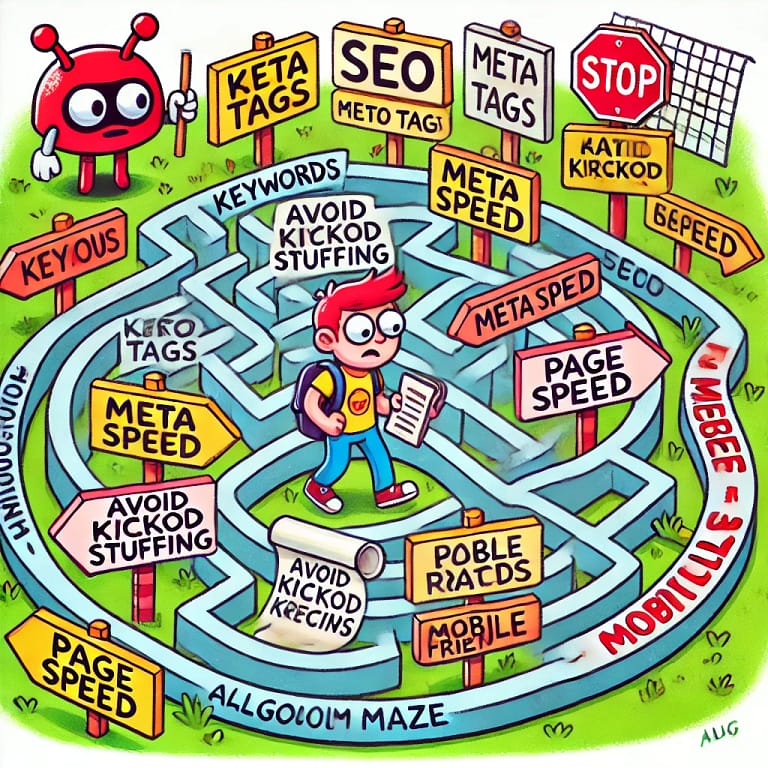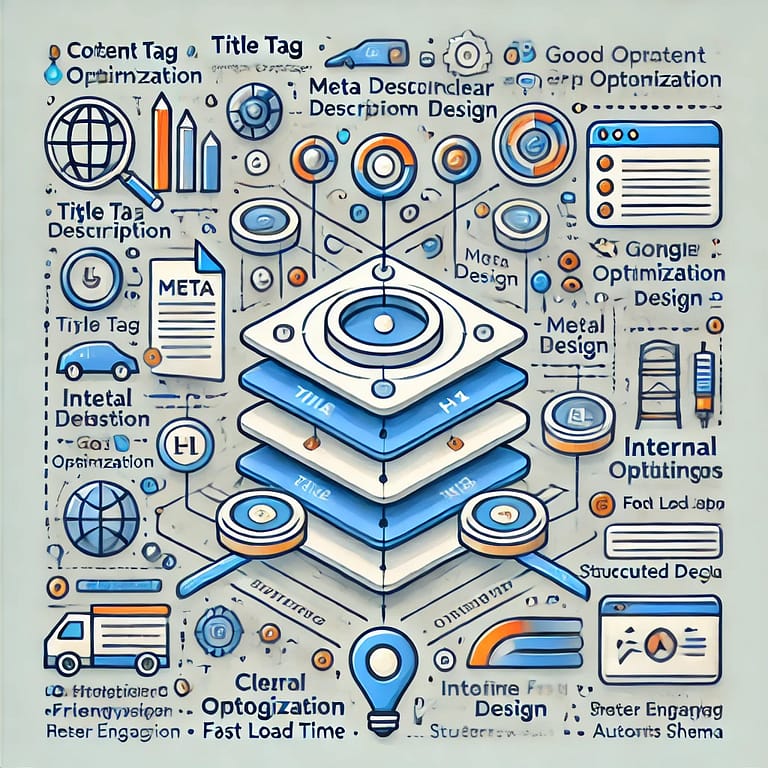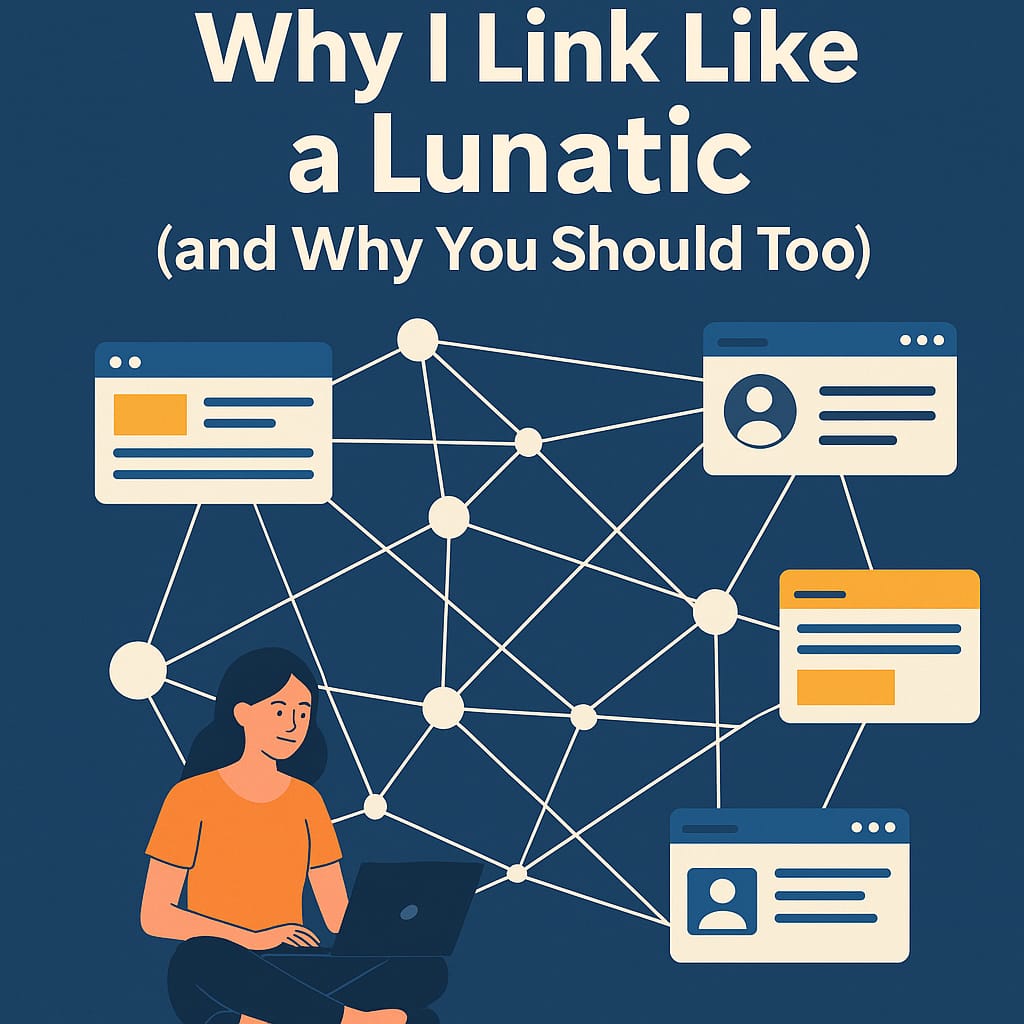
How to please the Google Algorithm
What is needed regarding content to please the algorithm of google so it understands what we are publishing , and what are the subsequent consequences
To please Google’s algorithm and ensure that it understands what you’re publishing, the primary goal is to create clear, relevant, and high-quality content that aligns with user intent. Google’s search algorithms are designed to interpret content by analyzing a variety of factors that signal quality, relevance, and authority. Here’s a breakdown of what’s needed to achieve this:
1. Keyword Optimization
- Primary Keywords: Ensure that your content focuses on well-researched keywords. These should match what users are searching for in relation to your topic.
- Latent Semantic Indexing (LSI) Keywords: These are related terms or phrases that help Google understand the broader context of your content. Avoid keyword stuffing but use variations of your keywords naturally throughout.
- Long-Tail Keywords: These are longer, more specific phrases. They often capture more targeted traffic and can indicate a clear user intent.
2. Content Structure and Clarity
- Clear Headings (H1, H2, H3): Use headings and subheadings to break up your content. This helps both users and Google to understand the hierarchy and organization of your content.
- Introduction and Conclusion: Start with a clear introduction that immediately answers what the article is about, and end with a conclusion that summarizes key points.
- Paragraphs and Formatting: Short paragraphs, bullet points, and bolded key terms make content easier to read and scan, both for users and search engines.
3. E-A-T: Expertise, Authoritativeness, Trustworthiness
- Author Credibility: Display the credentials or expertise of the content’s author. This helps Google determine the authority of your content, especially for niches like health, finance, or law.
- Cite Sources: Link to reputable, authoritative sources to back up your claims. Outbound links can improve your trustworthiness.
- Freshness and Accuracy: Regularly update your content to ensure it remains accurate and relevant. Fresh content is a key factor in some search results.
4. On-Page SEO Elements
- Title Tag: The title should include your primary keyword and be crafted to entice clicks. Keep it under 60 characters.
- Meta Description: Summarize the page’s content in 150-160 characters. Although this doesn’t directly impact rankings, it affects click-through rates (CTR).
- URL Structure: Use clean, descriptive URLs with keywords. Avoid long, complex URLs with unnecessary parameters.
- Alt Text for Images: Google can’t read images, so providing descriptive alt text with keywords helps both in ranking and for accessibility.
5. Content Quality and Length
- Comprehensive Content: Google rewards thorough, in-depth content. If your post covers a topic from multiple angles, it has a higher chance of being seen as authoritative.
- Word Count: While there’s no “ideal” word count, long-form content (1000-2000 words or more) often performs better for competitive terms, as it provides depth.
- Engagement Metrics: If users stay on your page longer (low bounce rate, high dwell time), this signals to Google that the content is relevant.
6. User Intent Alignment
- Match the Query Intent: Google aims to deliver content that matches the user’s intent, whether informational, navigational, or transactional. Understand what your audience is looking for (e.g., quick answers vs. detailed guides) and tailor your content to meet that intent.
- Answer Queries Clearly: Use the “People Also Ask” section on Google results to anticipate related questions and ensure your content answers these.
7. Internal and External Linking
- Internal Links: Link to other relevant content on your site to guide users and help Google crawl your site more effectively. This also spreads link equity.
- External Links: Linking to high-authority external sites gives Google confidence that your content is well-researched and connected to other authoritative sources.
8. Mobile-Friendliness
- Responsive Design: Your site must be mobile-friendly. Google now indexes mobile versions of sites first (mobile-first indexing), and poor mobile usability can drastically reduce your rankings.
9. Page Speed
- Fast Load Time: Optimize images, enable caching, and use a content delivery network (CDN) to ensure that your site loads quickly. Google prioritizes sites that load faster, especially on mobile devices.
10. Structured Data (Schema Markup)
- Rich Snippets: Adding schema markup helps search engines understand your content better. It can also enhance your SERP appearance (e.g., reviews, FAQs, events), leading to higher CTR.
Subsequent Consequences of Effective Content Optimization
- Higher Rankings: By adhering to the above best practices, Google is more likely to recognize your content as relevant and authoritative, resulting in higher rankings in search results.
- Increased Traffic: Better rankings will drive more organic traffic, especially if your content ranks for high-volume keywords and long-tail queries.
- Improved User Engagement: Well-optimized content that matches user intent will keep visitors on your site longer, reduce bounce rates, and potentially increase conversions.
- Enhanced Click-Through Rates (CTR): An optimized meta title and description, along with structured data (like rich snippets), make your content more appealing in search results, which improves your CTR.
- Long-Term Authority: Consistently producing high-quality content that follows Google’s guidelines can establish your site as an authority in your niche, leading to sustained traffic growth.
- More Backlinks: High-quality, in-depth content tends to attract natural backlinks from other sites, further boosting your site’s authority in Google’s eyes.
By focusing on clarity, structure, and SEO best practices, you not only improve your rankings but also create a positive feedback loop: better content leads to more engagement, backlinks, and authority, which in turn boosts your SEO performance.

LSI
Latent Semantic Indexing (LSI) refers to an approach that helps search engines like Google understand the context and relevance of content by analyzing related terms and concepts. While LSI is a specific mathematical method, in the SEO context, the term is often used loosely to describe related or semantically connected keywords that help search engines determine the overall topic of a page.
How LSI Works in SEO
LSI keywords are words or phrases that are contextually related to your primary keyword. They help search engines understand what your content is about beyond just the main keyword. This prevents misinterpretation and ensures the algorithm can accurately identify the topic and the relevance to a user’s search query.
For example, if your primary keyword is “apple”, without additional context, it’s unclear whether you’re referring to the fruit or the tech company. By including LSI keywords like “iPhone,” “MacBook,” or “Steve Jobs,” the search engine can clearly understand you’re talking about Apple Inc. On the other hand, using words like “fruit,” “orchard,” or “vitamin C” will indicate you’re referring to the apple as a fruit.
Why LSI Matters for SEO
- Avoiding Keyword Stuffing: Google frowns upon overloading content with the same primary keyword repeatedly (a practice called keyword stuffing). LSI keywords offer a natural way to vary your language while still helping Google understand your content’s focus.
- Improving Context and Relevance: By including semantically related terms, you create a more comprehensive and in-depth piece of content. Google’s algorithms use these related terms to verify the relevance and depth of your content in relation to the topic.
- Enhancing Ranking Potential: Pages that use LSI keywords intelligently often rank higher because they provide more context and are seen as more informative. Additionally, it helps your page rank for multiple related search queries, not just your primary keyword.
- Providing a Better User Experience: Using LSI keywords naturally within the content makes the text more readable and engaging for users, which in turn can reduce bounce rates and increase engagement—both positive signals for SEO.
Finding and Using LSI Keywords
- Google’s “People Also Ask” and Related Searches: When you search for a term, Google provides a list of related questions and related searches at the bottom of the page. These can give you an idea of the LSI keywords Google associates with your primary term.
- Keyword Research Tools: Tools like LSIGraph, SEMRush, Ahrefs, and Ubersuggest provide lists of related keywords and phrases you can integrate into your content. These tools often highlight semantically related keywords that search engines associate with your primary keyword.
- Content Creation Best Practices: Naturally include LSI keywords in key parts of your content:
- Titles and Subheadings: Use related keywords in H2 or H3 headings.
- Body Text: Integrate LSI keywords smoothly without forcing them, maintaining a natural flow.
- Meta Descriptions and Alt Text: Use relevant LSI keywords where appropriate.
- Semantic Context in Search Algorithms: Google’s RankBrain, a machine learning component of their algorithm, evaluates how terms are related to each other in a search context. LSI-like techniques enable the algorithm to understand whether a piece of content satisfies the user’s intent beyond just keyword matching. Therefore, integrating semantically related keywords can better align your content with what users are searching for.
Example of LSI in Action
Imagine you’re writing about “digital marketing”:
- Primary Keyword: digital marketing
- LSI Keywords: SEO, content marketing, social media strategy, PPC, email marketing, lead generation, conversion rate optimization, Google Analytics
By including terms like “content marketing” and “lead generation,” you’re indicating to Google that your article covers multiple aspects of digital marketing. This helps Google categorize your content as relevant for a broader set of related searches, improving your chances of ranking for multiple queries.
Key Takeaways
- LSI keywords help Google better understand the context of your content.
- They reduce the need for keyword stuffing by introducing relevant variations.
- Integrating LSI keywords can help your content rank for a broader range of related queries.
- LSI contributes to better content quality, which can enhance user engagement and SEO outcomes.
Effectively using LSI keywords aligns your content with Google’s goal of delivering the most comprehensive and contextually relevant results to users.

Example: Optimizing a Blog Post on “Digital Marketing”
Let’s walk through an example based on the breakdown we discussed earlier, using “Digital Marketing” as the main topic, while incorporating various SEO best practices and elements from our earlier conversation.
Title Tag
“Digital Marketing: Complete Guide to SEO, Social Media, and Content Strategies”
- Why it’s effective: The title includes the primary keyword “digital marketing” and includes secondary keywords like “SEO,” “social media,” and “content strategies” to capture broader searches. It’s concise and under 60 characters.
Meta Description
“Learn everything about digital marketing, from SEO and social media to content creation and PPC strategies. Get actionable insights to grow your online presence!”
- Why it’s effective: This description is clear, keyword-rich (SEO, social media, PPC, etc.), and appeals to the user by promising actionable insights. It’s within the 150-160 character limit, ensuring no cutoff in search results.
Headings (H1, H2, H3) Structure
- H1: The Ultimate Guide to Digital Marketing
- H2: What is Digital Marketing?
- H2: SEO (Search Engine Optimization) in Digital Marketing
- H3: Keyword Research
- H3: On-Page SEO Best Practices
- H2: Social Media Strategies for Digital Marketing
- H3: Choosing the Right Platform
- H3: Creating Engaging Content
- H2: Content Marketing and Lead Generation
- Why it’s effective: The headings are structured logically, with clear primary topics (H2) and subtopics (H3). This makes it easy for both Google and users to navigate the content.
Internal Links
- Link to your previous post on “How to Do Keyword Research for SEO.”
- Link to another article on “The Best Social Media Tools for Marketers.”
- Why it’s effective: Internal links help users discover related content on your site and keep them engaged longer. This also spreads link equity and helps with site crawlability.
External Links
- Link to authoritative sources like Google’s SEO Starter Guide, HubSpot’s Digital Marketing Hub, and Moz’s Content Marketing Best Practices.
- Why it’s effective: Linking to reputable sources builds trust and authority for your content, signals credibility to Google, and improves user experience.
Primary and LSI Keywords
- Primary Keyword: digital marketing
- LSI Keywords: SEO, social media marketing, content marketing, PPC, lead generation, Google Analytics, inbound marketing
- Why it’s effective: These related keywords help Google understand the full scope of the topic, improving relevance for multiple queries while avoiding keyword stuffing.
Mobile-Friendliness
- Ensure your site uses responsive design: Test it using Google’s Mobile-Friendly Test tool to ensure the content adjusts well on all device sizes.
- Why it’s effective: A mobile-friendly site is essential since Google uses mobile-first indexing, which impacts your rankings significantly.
Page Speed
- Optimize images, minify CSS and JavaScript, and use a CDN: This ensures the page loads in under 2-3 seconds, which is ideal for both users and search engine algorithms.
- Why it’s effective: Page speed is a confirmed ranking factor, especially for mobile. Faster load times reduce bounce rates and improve user experience.
Structured Data (Schema)
- Add schema markup for articles and reviews: This can help your blog post appear as a rich snippet in search results (e.g., with stars for reviews or as a featured article).
- Why it’s effective: Structured data helps search engines better understand your content and can improve your visibility in the form of rich snippets, leading to a higher CTR.
Content Length and Quality
- Target 2,000+ words for an in-depth guide on digital marketing, including examples, case studies, and actionable tips.
- Why it’s effective: Long-form content tends to rank higher for competitive keywords, as it signals thoroughness and authority.
Engagement Metrics
- Use interactive elements like infographics or videos to explain digital marketing strategies.
- Encourage comments or questions at the end of the post to boost user interaction.
- Why it’s effective: Higher user engagement (measured by time on page, comments, shares) signals to Google that users find your content valuable, which can positively influence rankings.
Subsequent Consequences
- Higher Rankings: By using a mix of primary keywords and LSI terms, you’ve made it easier for Google to understand the content’s focus and rank it for a variety of search queries.
- Increased Traffic: Rich snippets, well-optimized meta tags, and compelling content can attract more clicks and drive organic traffic to your site.
- Better Engagement: Interactive elements and a clear content structure keep users on the page longer, reducing bounce rates and improving dwell time.
- Long-Term Authority: As more people find value in your content, they’re more likely to link back to it, increasing your domain authority and visibility across search results.
Visual Summary Example
An illustration could depict a digital marketing blog post broken down into key sections:
- Primary keyword (“Digital Marketing”) in the title.
- LSI keywords branching off from the primary keyword, such as SEO, PPC, social media.
- On-page SEO elements: meta description, H1, internal links, external links.
- Technical SEO elements: mobile-friendliness, page speed, and schema markup.
This image would summarize how optimizing content with these elements aligns with SEO best practices and leads to improved rankings, traffic, and engagement.

I hope you liked it! 🦾🏆🚀
Source OpenAI’s ChatGPT Language Models and Dalle

Invest in your future & learn
Learn affiliate marketing & build your own website.
Heads up! Make sure you sign up using my referral link to get access to my personal coaching and all features.
👉 Sign Up




